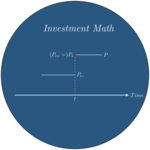Defining Returns
This post reviews the definition of returns. It looks at discrete time returns and log returns as well as at the operation of compounding. In the log return context, return compounding becomes additive, which proves very convenient. Log returns however depend in a non additive way in the components of returns (dividends and price appreciation)1. Continuous compounding arises as the discretization grid get finer. Continuous time often lends itself to closed analytical formulas.
Single period returns
Discrete time does not demand much mathematical sophistication, at least at first sight. Dates at which data are observed are forced to belong to a grid \(t=0, \delta, 2\delta, 3\delta, \ldots\) where \(1/\delta\) can be conveniently set a to natural number. If, as is customary, \(1\) corresponds to a year, we get a quarterly grid when \(1/\delta\) is set to \(4\). The price \((P_{t})\) of an asset will be defined on those dates only, as will income payments \((D_{t})\). In this context, the rate of return of the asset over the time interval \([t,t+\delta],\) is defined as: \[R_{t+\delta}=\frac{P_{t+\delta}-P_{t}+D_{t+\delta}}{P_{t}}=\frac{\Delta
P_{t+\delta}+D_{t+\delta}}{P_{t}}=\frac{P_{t+\delta}+D_{t+\delta}}{P_{t}}-1,\] or through:
\[1+R_{t+\delta}=\frac{P_{t+\delta}+D_{t+\delta}}{P_{t}}.\]
The interpretation of the time interval is key. If \(\delta =1/4\) is interpreted as a quarter, the above return is a quarterly return. It is practical to define an arithmetically annualized return \(\tilde{R}_{t+\delta}\) (multiplying \(R_{t+\delta}\) by \(1/\delta\); this is not as neat as we would like however since arithmetic compounding is not valid in this context - see below the compounding section) and similarly an arithmetically annualized income payment \(\tilde{D}_{t+\delta}\) leading to the following equation: \[\frac{\Delta
P_{t+\delta}+\tilde{D}_{t+\delta}\delta}{P_{t}}=\tilde{R}_{t+\delta}\delta\]
This clearly looks like a geometric differential equation:
\[\frac{dP_{t}+\tilde{D}_{t}dt}{P_{t}}=\tilde{R}_{t}dt.\]
Compounding
Returns computed across several time intervals require some care. Assume an investor buys the financial instrument at date \(t\) and manages to receive over each elementary time interval the return \(R_{t+k\delta}\) for \(k=1,\ldots, N\) (this involves reinvesting income into the contract; the quantity invested in the contract thus changes at each date). One can then compute the cumulated return as the product: \[1+R_{t\rightarrow t+N\delta}=(1+R_{t+\delta})\cdots
(1+R_{t+N\delta}).\]
For \(N=1/\delta\), we get an annual return.
Annualization is a geometric operation. One can use the logarithmic function to describe compounding as an arithmetic operation instead. Setting: \[r_{t}=\log(1+R_{t}),\]
we then have: \[1+R_{t\rightarrow
t+N\delta}=\exp\left(r_{t\rightarrow
t+N\delta}\right)=\exp\left(r_{t+\delta}+\cdots+r_{t+N\delta}\right).\]
All compounding operations applied to log-returns are arithmetic, including annualization.
Within the log return set-up, the difference equation reads:
\[\log(1+\frac{\Delta
P_{t+\delta}+D_{t+\delta}}{P_{t}})=\tilde{r}_{t+\delta}\delta\] where \(\tilde{r}_{t+\delta}\) is, adequately this time, the arithmetically annualized log return (\(r_{t+\delta}=\tilde{r}_{t+\delta}\delta\)). The drawback of this scheme is that:\[\log(\frac{\Delta
P_{t+\delta}+D_{t+\delta}}{P_{t}}),\] is not additive in the two components of the return, the price return and the dividend yield.
Continuous time
We have thus seen that in discrete time, we face a few hurdles. Compounding is geometric and this suggests to concentrate on log-returns. But for log returns, the return decomposition into price return and dividend yield is non-linear. Continuous time is analytically simpler. It can be recovered by letting the discretization get finer and finer. The return equation then becomes2: \[\frac{dP_{t}+\tilde{D}_{t}dt}{P_{t}}=\tilde{r}_{t}dt,\] where as before, the tilde notation is used to denote annualized variables. In particular, \(\tilde{r}_{t}\) is an annualized log return as in the absence of dividends for instance, the integral equation reads: \[P_{t}=P_{0}\exp\left(\int_{0}^{t}\tilde{r}_{u}du\right).\] In continuous time indeed, instantaneous returns and log-returns coincide3 since \[\frac{dP_{t}}{P_{t}}=d(\log(P_{t})).\]
Summary
We have looked at the definition of returns and log-returns both in discrete time and in continuous time. Both discrete time and continuous time entail their own challenges. Discrete time is usually more elementary from a mathematical standpoint (integrals are reduced to sums, differential equations to difference equations…), although quite often, closed form formulas are hard to come by. Continuous time involves more elaborate mathematical operations but provides more compact expressions. In what follows, I will try to make the best of both set-ups when introducing portfolio returns and uncertainty.
A later post will show a loglinear approximation of the discrete time log returns in the presence of dividends and capital gains. ## Links↩︎
Assuming standard calculus applies, as opposed to Ito calculus. Another post will explain what’s at stake behind these two modeling choices.↩︎
In standard calculus, as opposed to Ito calculus - see footnote \(2\).↩︎
